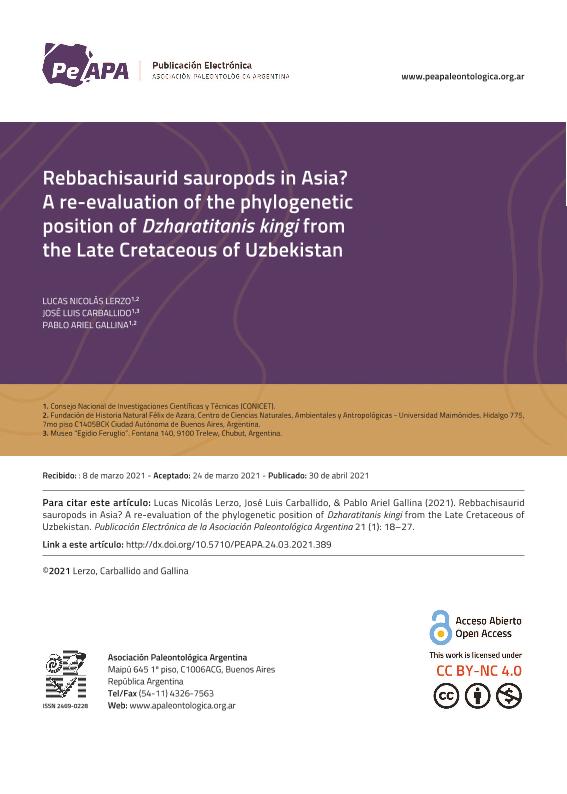Artículo
An isolated vertebra from the Late Cretaceous of Uzbekistan (Asia), previously interpreted as a titanosaur anterior caudal, was recently assigned as the holotype and unique specimen of a new rebbachisaurid taxon, Dzharatitanis kingi. This record would drastically impact both biogeographical and chronological aspects of the group. As some of the characters identified for such systematic assignment seem to have been incorrectly scored and/or have a more widespread distribution amongst Neosauropoda, we revised and discussed them in depth to verify the putative rebbachisaurid affinities of this taxon. The phylogenetic analyses carried out recovered Dzharatitanis as a titanosaur sauropod, most probably related to Lognkosauria. The extra steps needed to force Dzharatitanis within Rebbachisauridae confirms that its titanosaur affinity is not solely the most parsimonious hypothesis but also is well supported when the incompleteness of the material is taken into account. Given this new phylogenetic position, a new modified diagnosis is provided here. Although more complete evidence is needed, the reinterpretation of Dzharatitanis as a titanosaur with lognkosaurian affinities suggests a wider biogeographic distribution of this group of colossosaurs during the Cretaceous. At present, there is no reliable evidence to assume that rebbachisaurid sauropods have inhabited Asia. Una vértebra caudal aislada del Cretácico Tardío de Uzbekistán (Asia), previamente interpretada como una caudal anterior de titanosaurio, fue asignada recientemente como el holotipo y único espécimen de un nuevo rebaquisáurido, Dzharatitanis kingi. Este registro impacta drásticamente tanto en los aspectos biogeográficos como cronológicos del grupo. Como algunos de los caracteres identificados para dicha asignación sistemática parecen estar codificados incorrectamente y/o tener una distribución más amplia entre Neosauropoda, los mismos son revisados y discutidos en este trabajo con el fin de verificar las afinidades de este taxón con los rebaquisáuridos. Los análisis filogenéticos llevados a cabo recuperan a Dzharatitanis como un saurópodo titanosaurio, probablemente más relacionado a Lognkosauria. Los pasos extras necesarios para forzar Dzharatitanis dentro de Rebbachisauridae confirman sus afinidades con los titanosaurios, siendo esta no solo la hipótesis más parsimoniosa, sino que también está bien soportada cuando se tiene en cuenta la escasez del material. Dada esta nueva posición filogenética, aquí se proporciona una nueva diagnosis modificada. Aunque se necesita evidencia más completa, la reinterpretación de Dzharatitanis como un titanosaurio con afinidades a los lognkosaurios sugiere una distribución biogeográfica más amplia de este grupo de colossosaurios durante el Cretácico. Actualmente, no hay evidencia confiable para suponer que los saurópodos rebaquisáuridos hayan habitado Asia.
Rebbachisaurid sauropods in Asia?: A re-evaluation of the phylogenetic position of Dzharatitanis kingi from the Late Cretaceous of Uzbekistan
Título:
¿Saurópodos rebbaquisáuridos en Asia?: Una re-evaluación de la posición filogenética de Dharatitanis Kingi del Cretácico Tardío de Uzbekistán
Fecha de publicación:
04/2021
Editorial:
Asociación Paleontológica Argentina
Revista:
Publicación Electrónica de la Asociación Paleontológica Argentina
e-ISSN:
2469-0228
Idioma:
Inglés
Tipo de recurso:
Artículo publicado
Clasificación temática:
Resumen
Palabras clave:
Titanosauria
,
Cretaceous
,
Rebbachisauridae
,
Dinosauria
Archivos asociados
Licencia
Identificadores
Colecciones
Articulos(SEDE CENTRAL)
Articulos de SEDE CENTRAL
Articulos de SEDE CENTRAL
Citación
Lerzo, Lucas Nicolas; Carballido, José Luis; Gallina, Pablo Ariel; Rebbachisaurid sauropods in Asia?: A re-evaluation of the phylogenetic position of Dzharatitanis kingi from the Late Cretaceous of Uzbekistan; Asociación Paleontológica Argentina; Publicación Electrónica de la Asociación Paleontológica Argentina; 21; 1; 4-2021; 18-27
Compartir
Altmétricas




